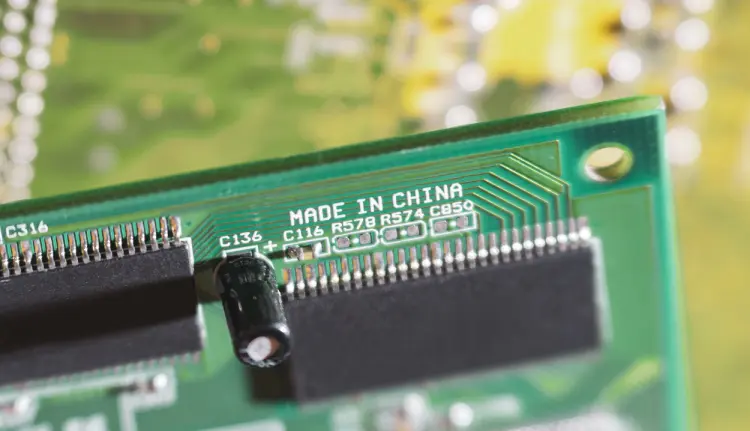US President Joe Biden has responded to global chip shortages and escalating geopolitical tensions with China by ordering a review of the country’s strategic supply chains. He is expected to devise a strategy that reduces the country’s reliance on China in key areas, including semiconductors and rare earth materials, which are used in their manufacture. This is likely to lead to higher prices for low-end chips and businesses will bear the brunt, unless the Biden administration provides subsidies to compensate for what would be a primarily geopolitical policy.

China’s role in the chip supply chain is under the microscope of the US Government. (Photo by Kakteen/Shutterstock)
The global chip supply has been disrupted this year by the impact of the Covid-19 pandemic, which has exposed structural fragilities in the semiconductor manufacturing process. Biden said this shortage has “caused delays in production of automobiles that has resulted in reduced hours for American workers”.
President Biden has also been under pressure to provide state aid to US chip companies, that have been losing ground to rivals in the Far East. According to a report on Asia Nikkei, one aim of Biden’s strategy is to develop supply chains that are less reliant on China by collaborating more closely with allies such as Taiwan, Japan and Australia.
Is a China-free chip supply chain possible?
China’s share of the chip manufacturing market is growing, and it edged ahead of the US in 2019. But it remains a minor contributor to global production, according to figures from the Congressional Research Service.
Removing China from the US chip supply chain shouldn’t be too tricky for the US, according to Risto Puhakka, president of semiconductor manufacturing analysts VLSI Research. “It’s not something that’s going to happen overnight – if you tried to do it in the next three months you would probably shut down half the world’s car factories,” he says. “But with a reasonable two-year transition period you could do it.”
[Keep up with Tech Monitor: Subscribe to our weekly newsletter]
High-end semiconductors, which are used in high-performance computing and the latest smartphones, are typically produced without much Chinese involvement, so would be the easiest segment to transition, Puhakka says. “These are still pretty much made away from China because Taiwan, South Korea and the US are the main manufacturers, and a lot of the materials come from Japanese companies,” Puhakka says.
But at the lower end of the market, which includes resistors and other common components used in all electronic devices, China is a much more important player. “Our analysis shows China has a 40% share of manufacturing for these components, so you would have a little work to do to shift that part of the chain,” Puhakka says.
China’s chokepoint: rare earth materials
The biggest risk in removing China from the US supply chain relates to rare earth metals and minerals, says Stephen Ezell, vice-president for global innovation policy at the Information Technology and Innovation Foundation (ITIF) think tank.
“This is the area where there is the highest dependency on China and where the most immediate impact on the supply chain could be,” he says. “China makes 97% of the world’s silicon and gallium, so if it reacted by restricting supply to these critical minerals you could see immediate disruption.”
China has form for restricting the supply of rare earth minerals. In 2010, it reportedly placed an embargo on exports to Japan as part of a territorial row over the Senkaku Islands, although the Chinese government denies this.
The US has already made moves to reduce its dependence on Chinese rare earth minerals. In January it was announced that Australian mining company Lynas would be building a rare earths separation plant in Texas with the help of a $30m grant from the US Department of Defence.
How will a China-free chip supply chain affect prices?
Without US government subsidies, prices for low-end semiconductors will increase if China is taken out of the supply chain, VLSI’s Puhakka says. “The only way you can reduce reliance on China is to build a factory base elsewhere,” he says. “Someone has to pay for that, and it’s going to be the customers because higher prices will come into play.”
Puhakka says costs were set to rise anyway due to the widespread shortage of chips, and US government interventions could exacerbate this. “Prices are going to shoot up and will continue to do so until additional capacity is built,” he says. “In certain areas, there may be a permanent price increase because the demand is so much higher than it was before, and the chipmakers will need to build extra capacity. Their business models do not allow for high capital investment so the only way they can do it is to increase prices.”
Subsidies for manufacturers could be made available through the provisions initially set out in the CHIPS for America Act, which is currently progressing through Congress having been rolled into the National Defence Authorization Act. But businesses will likely foot the bill for what is ultimately a geopolitical decision, Puhakka says. “My view is this issue is defence-related, rather than being trade-driven,” he says. “The military looks at it as a risk that their supply may be restricted by China’s role in the supply chain.”
Commercially, Puhakka says, “companies don’t care where they get their chips from as long as they are the cheapest possible and work as described”. He adds: “That’s why China has been able to take a substantial share of the lower end of the market. With that in mind, the US government will probably have to open its wallet a little bit to make this [change in supply chains] work.”





